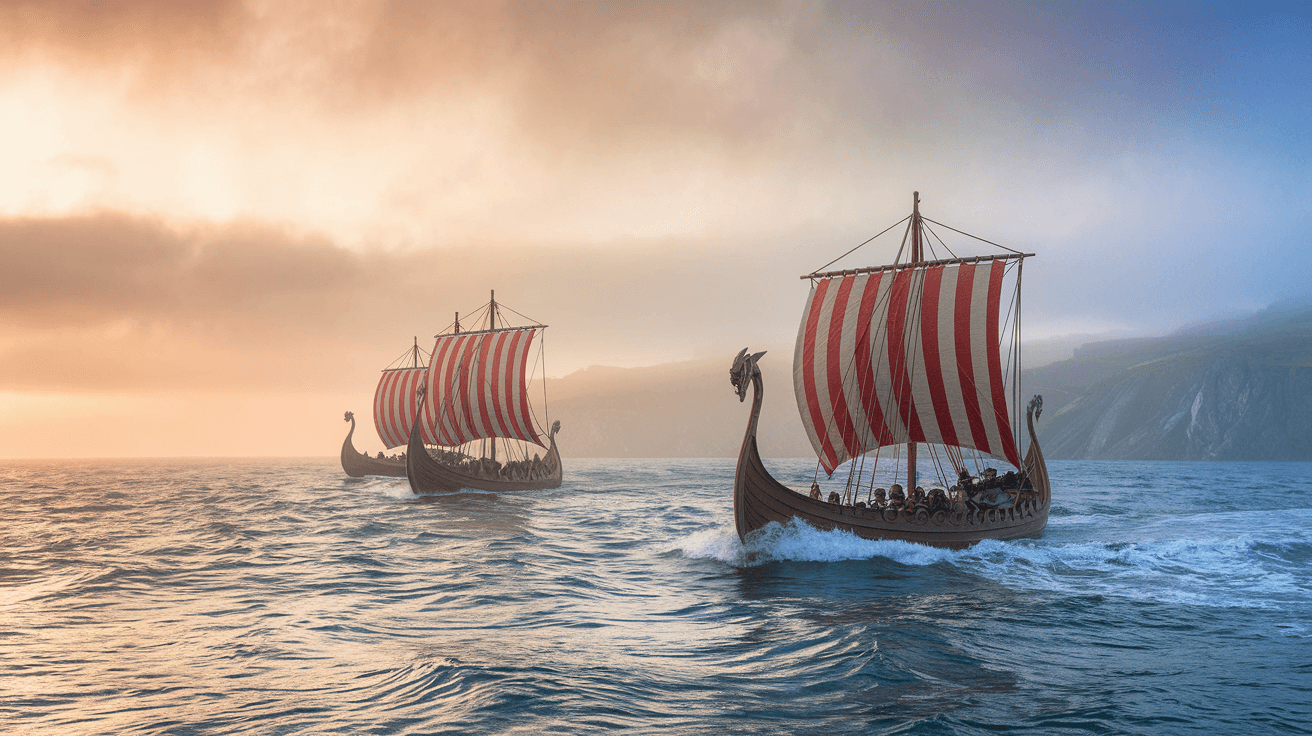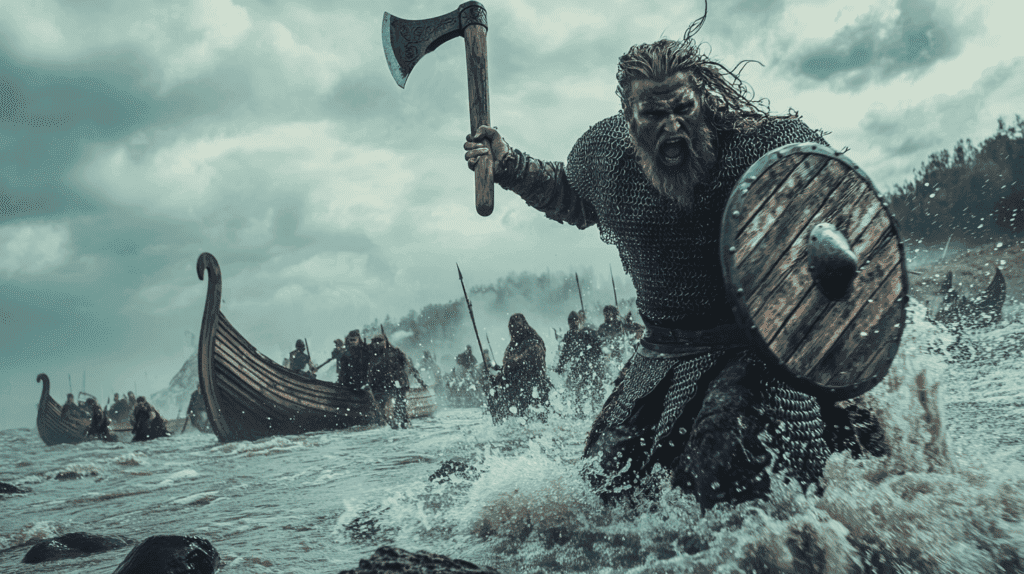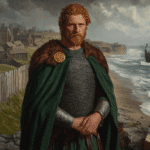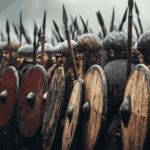
In the annals of Viking history, few figures loom as large or as enigmatically as Ivar the Boneless. A warrior of legendary prowess, a strategist of unparalleled cunning, and a leader whose very name struck fear into the hearts of his enemies, Ivar’s story is one of conquest, revenge, and the brutal realities of 9th-century warfare.
Born into the tumultuous world of Norse legend and history, Ivar Ragnarsson, as he was also known, emerged as a central figure in the Viking saga that would reshape the political landscape of Britain and Ireland. The son of the infamous Ragnar Lothbrok, Ivar inherited not only his father’s thirst for conquest but also a legacy steeped in myth and blood.
The origins of Ivar’s curious epithet, “the Boneless,” have been the subject of much speculation and debate among historians and storytellers alike. Some accounts paint a picture of a man born with a debilitating condition, perhaps osteogenesis imperfecta, which left him unable to walk. Others suggest a more metaphorical interpretation, hinting at his serpentine agility in battle or his reputation for being impervious to injury. The truth, like much of Ivar’s life, remains shrouded in the mists of time and legend.
In the TV series Vikings, in which Ivar the Boneless is played by Alex Høgh Andersen, he is portrayed as physically disabled and a clever tactician.

The Great Heathen Army
Ivar’s true rise to prominence began in 865 CE, with the arrival of the Great Heathen Army on English shores. This was no mere raiding party, but a force of unprecedented size and ambition, intent on conquest rather than simple plunder. At its head stood Ivar and his brothers, Halfdan and Ubba, their hearts set on vengeance for the death of their father, Ragnar Lothbrok, allegedly thrown into a snake pit by King Ælla of Northumbria.
The invasion of England unfolded like a masterclass in Viking warfare. Landing first in East Anglia, where they met little resistance, Ivar and his forces quickly turned their sights northward to Northumbria. York, the jewel of the north, fell to the Vikings in 866, a testament to Ivar’s tactical acumen and the sheer might of the Great Heathen Army.
But it was in 867 that Ivar’s true nature as a military commander came to the fore. As the deposed Northumbrian king Osbert and his usurper Ælla set aside their differences to face the common threat, Ivar prepared for the decisive battle. The Vikings appeared to flee from the approaching Northumbrians, encouraging them to recklessly attack. However, once engaged in combat the Vikings all returned to battle and the Northumbrians were out-numbered. Surrounded, the Northumbrians fought bravely until both Osberht and Ælla were killed. Leaderless, the surviving Northumbrians made peace with the Vikings and the latter appointed a puppet king of Northumbria, named Ecgberht.
The Blood Eagle and the Nature of Viking Vengeance
It is here that we encounter one of the most chilling aspects of Ivar’s legend: the execution of King Ælla by the infamous “blood eagle” ritual. According to some accounts, Ivar ordered this gruesome form of execution as revenge for his father’s death. The victim’s back was cut open, the ribs separated from the spine, and the lungs pulled out through the wounds to resemble bloody wings. While the historicity of this practice remains debated, its inclusion in the sagas speaks volumes about the reputation for brutality that Ivar and his compatriots cultivated.
This act of vengeance, whether real or apocryphal, cemented Ivar’s reputation as a leader to be feared. It sent a clear message to any who would oppose the Vikings: resistance would be met with unimaginable cruelty.
Conquest and Strategy
With Northumbria secured, Ivar turned his attention to the rest of England. His approach was not one of mindless violence, but of calculated strategy. In Mercia, he demonstrated a willingness to withdraw in the face of superior numbers, preserving his forces for future battles. This pragmatism, combined with his fearsome reputation, allowed Ivar to navigate the complex political landscape of 9th-century Britain with remarkable success.
Ivar’s cunning was perhaps best exemplified in his dealings with King Edmund of East Anglia. According to legend, Ivar approached Edmund not as a conqueror, but as a supplicant, asking only for as much land as he could cover with an ox hide. When Edmund agreed, Ivar cut the hide into thin strips, encircling enough land to build a fortress. This tale, reminiscent of the founding myth of Carthage, highlights Ivar’s reputation for cleverness and his ability to outmanoeuvre his opponents both on and off the battlefield.

Eventually Ivar executed the East Anglian king – making him known to history as Edmund the Martyr – for refusing his demand that he renounce Christ. Edmund was tied to a tree and whipped before being shot with arrows until his body resembled “the bristles of a hedgehog.” Despite this brutal treatment, he continued to call upon Jesus Christ for strength. Finally, after enduring prolonged suffering, Edmund was beheaded by the Vikings. His severed head was thrown into a dense forest to prevent his followers from giving him a proper Christian burial.
Beyond Britain: Ireland and Scotland

Ivar’s ambitions were not limited to England alone. In partnership with Olaf the White, the Danish king of Dublin, Ivar extended his influence into Ireland and Scotland. Their campaigns in these lands were marked by the same mix of military prowess and political acumen that had served Ivar so well in England.
In 870, Ivar and Olaf led a devastating attack on Dumbarton, the capital of the Strathclyde kingdom in Scotland. The siege and subsequent destruction of this stronghold demonstrated the Vikings’ ability to project power far beyond their traditional spheres of influence. It was a clear signal that no part of the British Isles was beyond the reach of Ivar’s ambitions.
The Legacy of Ivar the Boneless
By 871, Ivar had achieved a position of unprecedented power, styled as “king of the Norsemen of all Ireland and Britain”. His realm stretched across vast swathes of territory, from Dublin to York and beyond. Yet, like many great conquerors, Ivar’s empire would prove ephemeral.
Ivar’s death in 873 in Dublin marked the end of an era. The great Viking leader, who had terrorized and transformed the British Isles, passed into legend. The cause of death – a sudden and horrible disease according to one Anglo-Saxon source – raises the possibility that the true origin of Ivar’s Old Norse nickname lay in the crippling effects of an unidentified disease that struck him down at the end of his life.
More than a millennium after his death, Ivar the Boneless continues to captivate our imagination. His story is one of ambition, conquest, and the complex interplay of myth and history. In Ivar, we see reflected the Viking age in all its terrible glory – the fierce warriors, the cunning leaders, the clash of cultures that would reshape medieval Europe. Whether seen as a disabled man who overcame his limitations to become one of the most feared warriors of his age, or as a brilliant strategist whose nickname belied his true nature, Ivar remains an enigma.




